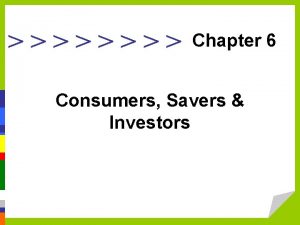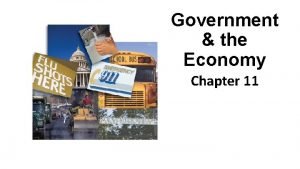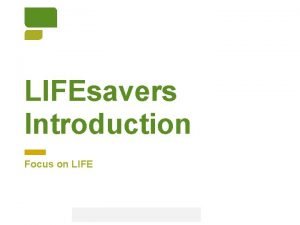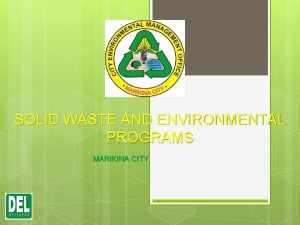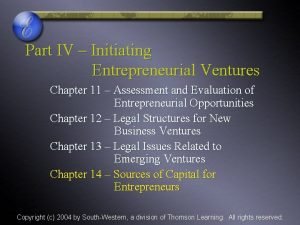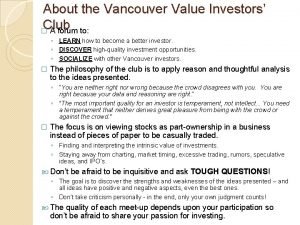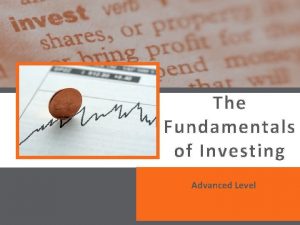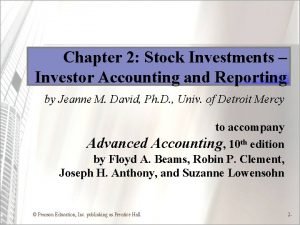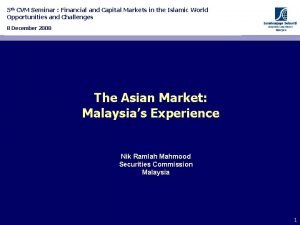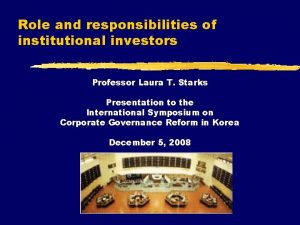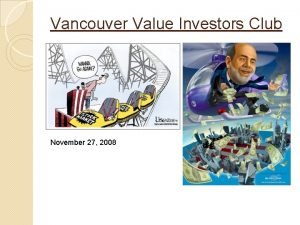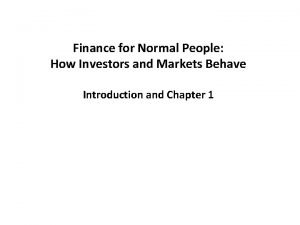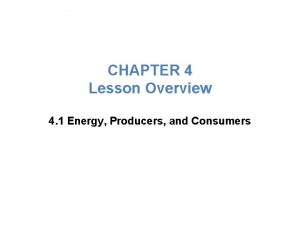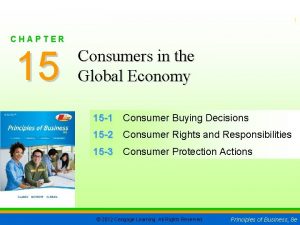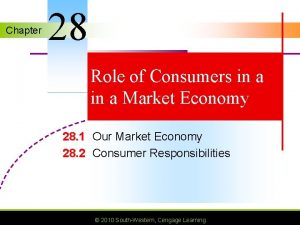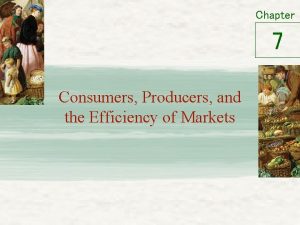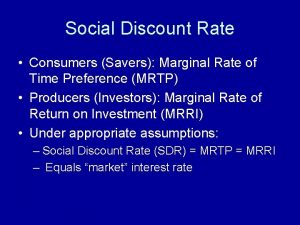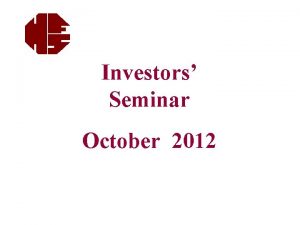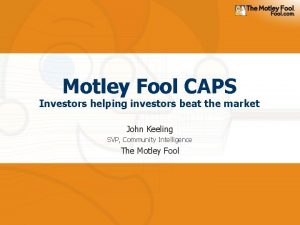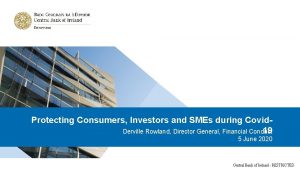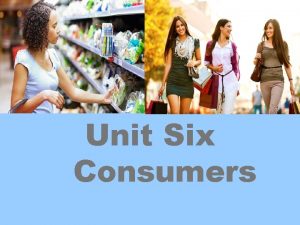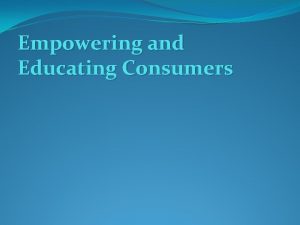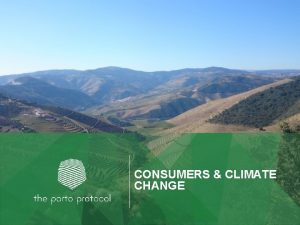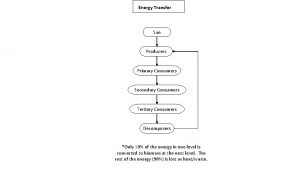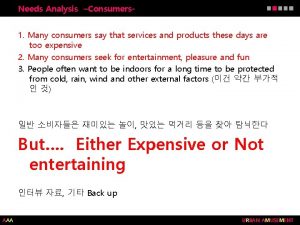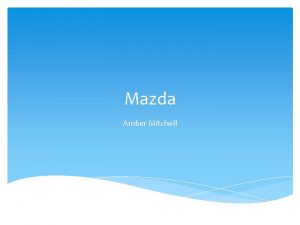Chapter 6 Consumers Savers Investors s l a




























- Slides: 28

>>>> Chapter 6 Consumers, Savers & Investors

s l a o G g Learnin 1 Outline the structure and importance of the financial system. List the various types of securities. 5 Discuss the organization and functioning of financial institutions. 6 Explain the functions of the Federal Reserve System and the tools it uses to control the supply of money and credit. 2 3 Define financial market, and distinguish between primary and secondary financial markets. 7 Describe the characteristics of the major stock exchanges. 4 Evaluate the major features of regulations and laws affecting the financial system. 8 Describe the global financial system.

s r e v a S & s r e d n Spe Teens spent $159 billion in 2005! Almost 2/3 s was spent on consumer goods & services

t c u d o r P c i t s e m o D s s Gro • GDP is the final value of all goods & services produced in the country in one year • If a country can increase its GDP it will see an increase in its standard of living • The U. S. has the highest GDP in the world (it produces more goods & services than any other country)!

e m o c n I f o s e c r u So • 2 Main Sources: – Income from work: Paid by wage (hourly or by unit of production) or by a salary (paid weekly, monthly or yearly) – Income from wealth • Wealth is the value of the things you own. • Net worth is a person’s wealth after debts & other obligations have been subtracted • Use your wealth (interest) as income too!

e m o c n I f o Types • Disposable Income (or net pay) is the money you take home after taxes are paid (As a whole most Americans spent more than their disposable income in 2006!) • Discretionary income is what may be spent on extras

g n i t c e f f Factors A Savings • Income -People save & invest more as income • Expectations - What people think, or hope, will happen in the future • Current interest rates – higher interest promotes saving; lower interest does not • Taxes – tax rates encourage or discourage savings

Budget • A budget can help you save money 3 Steps in preparing a budget: 1. Setting financial goals 2. Estimating income 3. Planning expenditures (a spending plan)

g n i s i t r e v Ad • Informs consumers, creates competition (lower prices) & pays for TV & newspapers • Advertising is expensive & can raise prices, it can lead people to buy things they don’t need and businesses may not be objective because they support TV & newspapers

g n i v a S r o f s r o t c a 3 F • Safety - offers protection from risks • Rate of return - “the higher the risk, the greater the return. ” • Liquidity – how easily it can be converted to cash - The more liquid, the less the rate of return

s g n i v a S f Types o • Savings Deposits – low risk, very liquid, low interest • Certificate of Deposit (CD) – pays more interest because you agree to deposit money in an account for a specific time period • Money Market Deposit Accounts – interest -bearing checking account; your money is used in the money market

s t n e m t s e v n I f o s e p Ty • Pension & Retirement Funds – These provide tax deferment (payment of taxes on interest after the interest is earned) • Corporate Stocks - shares of ownership in a corporation; most pay dividends & provide a way to invest to earn money over many years (if they appreciate) • Corporate bonds – IOUs to allow business expansion

s t n e m t s e v n I f o s e p Ty • Mutual fund – a pool of money used by a company to buy assets (stocks or bonds) • U. S. savings bonds – one of the safest investments which allow the Federal government to borrow money • Risk is associated with investment but it can provide income for retirement!

? t i d e r c What is • Credit – the ability of a customer to buy goods & services now and pay for them later • Principal – the amount originally borrowed • Finance charge – the total amount paid to use credit • Annual Percentage Rate (APR) – is the cost of credit calculated as an annual percentage of the principal borrowed

t i d e r c f o s e g a t Advan • • • Immediate possession Flexibility Safety Emergency funds Character reference

t i d e r c f o s e g a t n a v d Disa • Overspending • Higher cost • Impulse buying

t i d e r C g n i a t b O • The 3 C’s of Credit Worthiness: 1. Character – honesty & willingness to repay debts 2. Capacity – your ability to repay debts 3. Capital – or collateral is what people own

n o i t c e t o r P r e m u s n Co • In 1962 President John F. Kennedy’s proposed a consumer “bill of rights” to Congress: 1. The right to safety 2. The right to be informed 3. The right to choose 4. The right to be heard

t i s o p e D Federal e c n a r u s n I • Enacted by the Banking Act of 1933 • Restore public confidence in the banking system • Before deposit insurance, runs were common as people rushed to withdraw their money from the bank • Deposit insurance shifts the risk of bank failures from individuals to the FDIC

d n a s k n a B s g n i v a S s n o i n U t i d Cre • Offer a variety of consumer services • 85% of their loans are real estate loans • Credit unions are cooperative financial institutions that are owned by depositors/members. • Credit unions are created to serve consumers. – Insured by National Credit Union Administration (NCUA) which functions the same as the FDIC

y r o t i s o p e Non D s n o i t u t i t s n I l a i c n a Fin ü Insurance Companies ü Pension Funds ü Finance Companies

l a r e d e F e h t f o e l o The R Reserve • Created In 1913 • Central bank of the United States • Regulate commercial banks • Perform banking-related activities for the U. S. Department of Treasury • Providing services for banks • Setting monetary policy

e h t f o n o i Organizat e v r e s e R l Federa • 12 Federal reserve districts – Own federal reserve bank • District banks are run by a nine-member board of directors. • The board of governors is the governing body. • Politically independent • Federal Open Markets Committee (FOMC) sets most policies concerning monetary policy and interest rates.

g n i r a e l C k Chec the Fed and • Americans still write billions of paper checks. • The process by which funds are transferred from the check writer to receiver • The multiple-step process is managed and cleared by the FED. • The Check Clearing for the 21 st Century Act is making this process more electronic.

y c i l o P y r Moneta • Supply of money and credit • Measures of the money supply: M 1 & M 2 • The FED requires banks to maintain reserves. • Set the discount rate • Open Market Operations

c i h p a r G M 1 & M 2

e h t f o n o Regulati m e t s y S l a i Financ • Bank Regulation • Government Regulation of the Financial Markets • Industry Self-Regulation – Rules of conduct by professional organizations like National Association of Securities Dealers – Market Surveillance

: m e t s y S l a The Financi e v i t c e p s r e Global P A • The financial system is more connected. • Financial institutions are more global. • Only 3 of the 30 largest banks in the world are US institutions. • Most nations have a central bank.
 Savers and investors role in financial markets
Savers and investors role in financial markets Protecting consumers savers and investors examples
Protecting consumers savers and investors examples Savers and investors role in financial markets
Savers and investors role in financial markets Food web vs food chain
Food web vs food chain Primary producers
Primary producers Chapter iv investors
Chapter iv investors Life savers cargill
Life savers cargill Energy tax savers
Energy tax savers Garbage collection schedule marikina
Garbage collection schedule marikina Sanantha fish
Sanantha fish Pros and cons of angel investors
Pros and cons of angel investors Investors
Investors Monash investors
Monash investors Los angeles angie rupert
Los angeles angie rupert The value investors club
The value investors club Good morning investors
Good morning investors Investors in accounting
Investors in accounting The railroad had primary investors who were known as
The railroad had primary investors who were known as Cvm investors hub
Cvm investors hub Roles and importance of institutional investors
Roles and importance of institutional investors Value investors club
Value investors club Normal people chapter 1
Normal people chapter 1 Energy producers and consumers lesson 1
Energy producers and consumers lesson 1 Chapter 15 consumers in the global economy
Chapter 15 consumers in the global economy Chapter 28 role of consumers in a market economy
Chapter 28 role of consumers in a market economy Chapter 7 consumers producers and the efficiency of markets
Chapter 7 consumers producers and the efficiency of markets Examples of producers
Examples of producers Map of the tundra biome
Map of the tundra biome Tropical rainforest ecosystem consumers
Tropical rainforest ecosystem consumers
